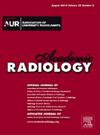Diagnostic Performance of Multiparametric MRI for the Detection of suspected Prostate Cancer in Biopsy-Naive Patients: A Systematic Review and Meta-analysis
IF 3.8
2区 医学
Q1 RADIOLOGY, NUCLEAR MEDICINE & MEDICAL IMAGING
引用次数: 0
Abstract
Rationale and Objectives
This meta-analysis aimed to assess the diagnostic accuracy of multiparametric MRI (mpMRI) in detecting suspected prostate cancer (PCa) in biopsy-naive men.
Materials and Methods
PubMed, Scopus, and the Cochrane Library databases were systematically searched for studies published from January 2013 to April 2024. Sixteen studies comprising 4973 patients met the inclusion criteria. Data were extracted to construct 2×2 contingency tables for sensitivity, specificity, positive predictive value (PPV), and negative predictive value (NPV). A random-effects model was used for pooled estimation, and subgroup analyses were conducted. Summary receiver operating characteristic (SROC) curves were generated to summarize overall diagnostic performance.
Results
The overall detection rate of PCa across studies was 57.3%. For detecting any PCa, mpMRI showed pooled sensitivity of 82% (95% CI, 80–83%) and specificity of 62% (95% CI, 60–64%), with positive likelihood ratio (LR) of 1.97 (95% CI, 1.71–2.26), negative LR of 0.28 (95% CI, 0.24–0.34), and diagnostic odds ratio (DOR) of 7.34 (95% CI, 5.60–9.63), and an area under the SROC curve of 0.81. For clinically significant PCa (csPCa), mpMRI had pooled sensitivity of 88% (95% CI, 87–90%) and specificity of 64% (95% CI, 63–66%), with positive LR of 2.49 (95% CI, 2.03–3.05), negative LR of 0.20 (95% CI, 0.16–0.25), DOR of 13.83 (95% CI, 9.14–20.9), and area under the curve of 0.90.
Conclusion
This meta-analysis suggests that mpMRI is effective in detecting PCa in biopsy-naive patients, particularly for csPCa. It can help reduce unnecessary biopsies and lower the risk of missing clinically significant cases, thereby guiding informed biopsy decisions.
多参数磁共振成像对活检无效患者疑似前列腺癌的诊断性能:系统回顾与元分析》。
依据和目的:这项荟萃分析旨在评估多参数磁共振成像(mpMRI)在检测未经活检的男性疑似前列腺癌(PCa)方面的诊断准确性:系统检索了 PubMed、Scopus 和 Cochrane Library 数据库中 2013 年 1 月至 2024 年 4 月期间发表的研究。符合纳入标准的有16项研究,共4973名患者。提取的数据用于构建敏感性、特异性、阳性预测值(PPV)和阴性预测值(NPV)的 2×2 或然率表。采用随机效应模型进行汇总估算,并进行亚组分析。生成了接收者操作特征曲线(SROC),以总结总体诊断性能:各项研究的 PCa 总检出率为 57.3%。mpMRI检测任何PCa的集合敏感性为82%(95% CI,80-83%),特异性为62%(95% CI,60-64%),阳性似然比(LR)为1.97(95% CI,1.71-2.26),阴性LR为0.28(95% CI,0.24-0.34),诊断几率比(DOR)为7.34(95% CI,5.60-9.63),SROC曲线下面积为0.81。对于有临床意义的 PCa(csPCa),mpMRI 的集合敏感性为 88%(95% CI,87-90%),特异性为 64%(95% CI,63-66%),阳性 LR 为 2.49(95% CI,2.03-3.05),阴性 LR 为 0.20(95% CI,0.16-0.25),DOR 为 13.83(95% CI,9.14-20.9),曲线下面积为 0.90:这项荟萃分析表明,mpMRI 能有效检测活检无效患者的 PCa,尤其是 csPCa。它有助于减少不必要的活组织检查,降低遗漏有临床意义病例的风险,从而为知情的活组织检查决策提供指导。
本文章由计算机程序翻译,如有差异,请以英文原文为准。
求助全文
约1分钟内获得全文
求助全文
来源期刊

Academic Radiology
医学-核医学
CiteScore
7.60
自引率
10.40%
发文量
432
审稿时长
18 days
期刊介绍:
Academic Radiology publishes original reports of clinical and laboratory investigations in diagnostic imaging, the diagnostic use of radioactive isotopes, computed tomography, positron emission tomography, magnetic resonance imaging, ultrasound, digital subtraction angiography, image-guided interventions and related techniques. It also includes brief technical reports describing original observations, techniques, and instrumental developments; state-of-the-art reports on clinical issues, new technology and other topics of current medical importance; meta-analyses; scientific studies and opinions on radiologic education; and letters to the Editor.
 求助内容:
求助内容: 应助结果提醒方式:
应助结果提醒方式:


